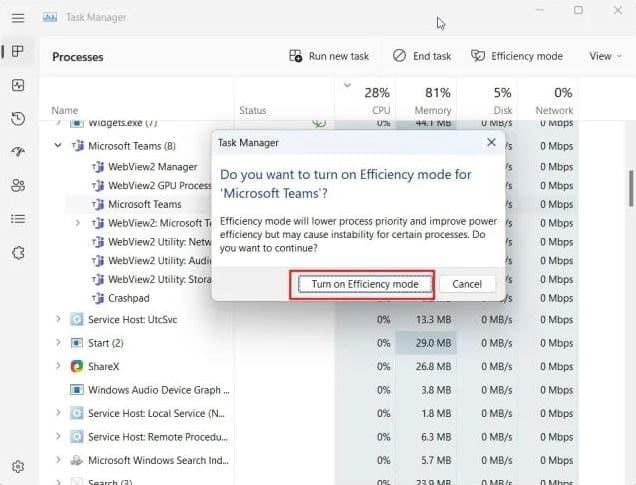For Windows users, slow performance is a common issue. Especially when we have windows with a lot of material and with a huge number of processes running that causes it to have a very significant load. And sometimes you may experience windows 11 High CPU usage or disk usage problems that slow down the PC. Well with the latest windows 11 OS Microsoft has introduced the Efficiency Mode feature and enabling this feature free up your CPU and reclaims your resources. Here in this post, we go through What is Efficiency Mode in Windows 11 and How It Works? Also, we see how you Lower the Burden on Your CPU With Task Manager’s Efficiency Mode on Windows 11.
You can extend battery life, free up memory and CPU cycles by putting certain apps into ‘Efficiency Mode.’
What Is Efficiency Mode in windows 11?
Efficiency mode is a new feature that you can find under Windows 11 Task Manager, that helps us to limit the consumption of CPU resources while executing less important tasks. And as a result, your device can run as efficiently as possible and more resources are available for processes of the highest importance for users.
This means that processes with higher priority run faster. Everything works as efficiently as possible, so there are always resources available for the processes that really need power.
We can say this feature is introduced to solve the problem of wasting system resources uselessly in the background, by processes that are of no value to either the system or the user.
According to Microsoft’s own tests, enabling the efficiency mode on windows 11 improves the overall performance of a computer by approximately 14% to 76%.
How does Efficiency Mode work on windows 11?
In order to use it, the first thing we must do is understand what exactly this mode does when it is enabled so that we can use it in the best possible way.
Putting efficiency into operation means two very significant changes that you should know about. The first is the base priority level of the process and the second is that the QoS mode is changed to EcoQoS.
The base priority
When a process is assigned a low priority level, the CPU gives it little importance and instead places it at the bottom of the processing queue.
This means that the rest of the processes that are not in that mode are given a higher priority, they are the first and the ones with the most resources, making them run faster, which means that we achieve better performance.
From QoS to EcoQoS mode
When switching from QoS to EcoQoS, the CPU automatically directs lower priority tasks to the most power-efficient processor cores as it is able to control the clock frequency.
According to Microsoft, EcoQoS not only minimizes the CPU frequency and saves power, but also reduces the heat output of the cores, keeping the noise of the computer’s fan very low.
The performance with EcoQos may not be the same and it may drop slightly, but it is what we will have when running the efficiency mode.
How to enable or disable efficiency mode
Once we know what is efficiency mode and how it works, it only remains to know how we can enable it to start working with it.
- First, open taskmanager using Ctrl + Shift + Esc key
- Right-click the process you want to enable Efficiency mode for.
- In the contextual menu that appears we choose, of course, the efficiency mode.
- Click the Turn on Efficiency mode button in the confirmation pop-up.
If the option for Efficiency mode is unavailable for a process, it means it’s a core process. You cannot enable efficiency mode for these processes as throttling them will affect your system.
If the task for which you have enabled efficiency mode depends on another parent process, the green leaf will be displayed next to the parent process, while efficiency mode will be written next to the child process.
From now on we will be able to better filter the main and secondary processes that are executed in efficiency mode, putting everything to our liking.
To disable the efficiency mode, simply right-click the child process and deselect the option for ‘Efficiency mode’ from the menu.
More information on efficiency mode
The best way to make efficiency mode work correctly is to organize the tasks that consume the most CPU resources in descending order in Task Manager . From there we should filter the tasks that are less relevant from the list, enabling the efficiency mode in them, so that the others have more resources at their fingertips.
You must be clear that this mode is only for managing computer resources. At no time is the RAM memory, the network or other types of resources touched, since the system considers all of this to be essential, that is, untouchable.
Also read:


